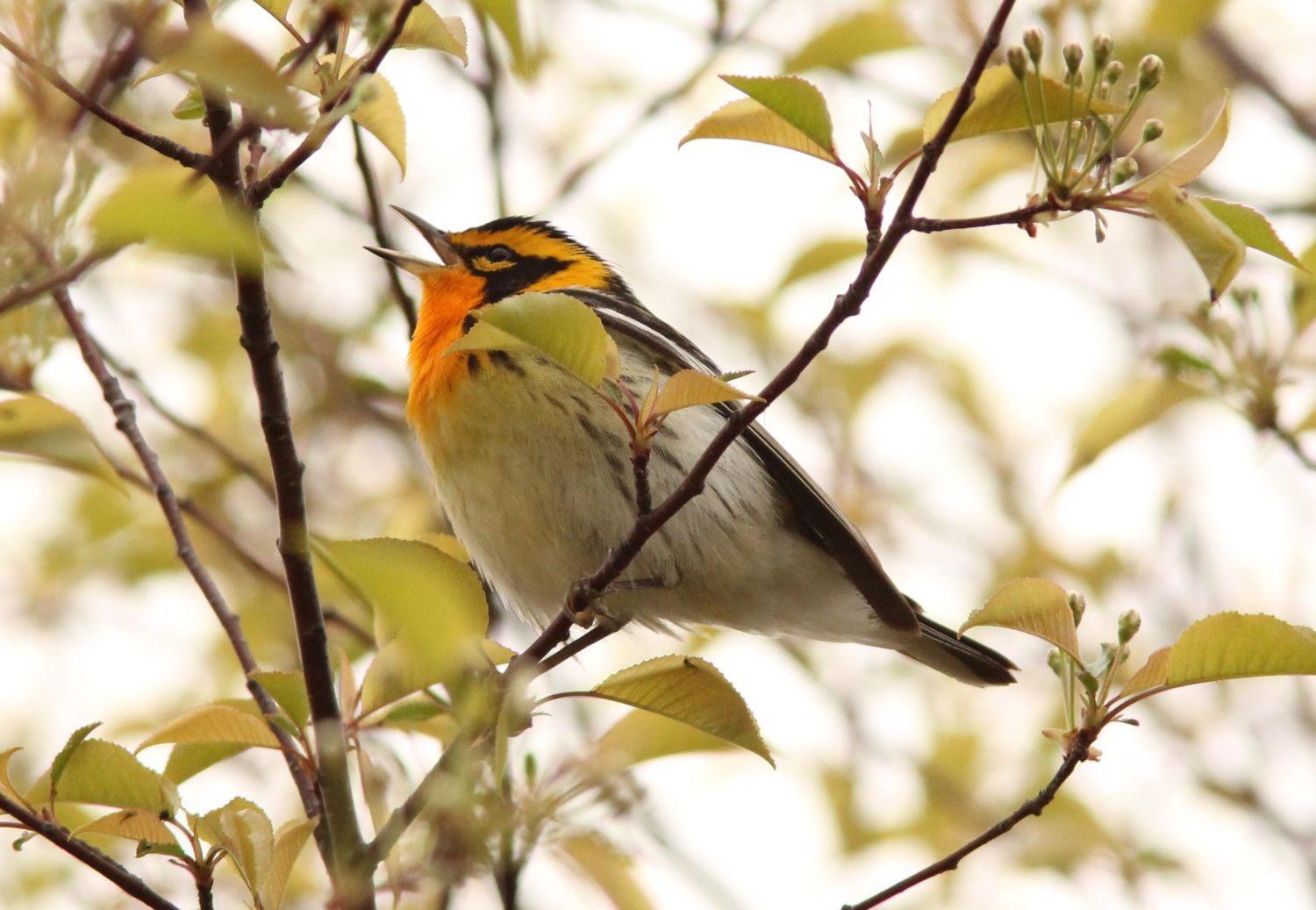Blackburnian Warbler
A species of Setophaga Warblers, Also known as Firethroat Scientific name : Setophaga fusca Genus : Setophaga Warblers
Blackburnian Warbler, A species of Setophaga Warblers
Also known as:
Firethroat
Botanical name: Setophaga fusca
Genus: Setophaga Warblers
Content
Description People often ask General Info
 Photo By Caleb Putnam , used under CC-BY-SA-2.0 /Cropped and compressed from original
Photo By Caleb Putnam , used under CC-BY-SA-2.0 /Cropped and compressed from original Description
Blackburnian warblers are small passerines and average-sized wood-warblers. They measure around 11 to 13 cm (4.3 to 5.1 in) long, with a 20 to 22 cm (7.9 to 8.7 in) wingspan, and weigh 8 to 13 g (0.28 to 0.46 oz). The average mass of an adult bird is 9.7 g (0.34 oz), although is slightly higher in fall due to fat reserves, averaging 10.2–10.4 g (0.36–0.37 oz). Among standard measurements, the wing chord is 6.3 to 7.3 cm (2.5 to 2.9 in), the tail is 4.2 to 5 cm (1.7 to 2.0 in), the bill is 0.9 to 1 cm (0.35 to 0.39 in) and the tarsus is 1.6 to 1.8 cm (0.63 to 0.71 in). In summer, male Blackburnian warblers display dark gray backs and double white wing bars, with yellowish rumps and dark brown crowns. The underparts of these birds are white, and are tinged with yellow and streaked black. The head is strongly patterned in yellow and black, with a flaming-orange throat. It is the only North American warbler with this striking plumage. Other plumages, including the fall male and adult female, are washed-out versions of the summer male, and in particular lack the bright colors and strong head pattern. The Blackburnian warbler is practically unmistakable if seen well, even the female due her dull-yellow supercilium, contrasting with greyish cheeks and yellow throat contrasting with the dark streaky sides and back. The only other wood-warbler with an orange throat is the flame-throated warbler of Central America and is very distinctive, lacking the contrasting blackish streaking about the head and whitish underside of a male Blackburnian. Basic plumages show weaker yellows and gray in place of black in the breeding male. Blackburnian warblers' songs are a simple series of high swi notes, which often ascend in pitch. Transliterations have included zip zip zip zip zip zip zip zip, titititi tseeeeee or teetsa teetsa teetsa teetsa. Their call is a high sip. Genetic research has shown that their closed living relative is the bay-breasted warbler, the latter species perhaps specialized to forage in the same coniferous trees at lower levels. Hybridization in the wild has been recorded once each with a bay-breasted warbler (in West Virginia, with a black-and-white warbler (in Pennsylvania) and possibly a wintering hybrid with a Kirtland's warbler (in Hispaniola). 
Size
13 cm (5 in)
Colors
Brown
Black
Yellow
Gray
White
Life Expectancy
8 years
Nest Placement
Tree
Clutch Size
3 - 5 eggs
Incubation Period
1 brood
Number of Broods
12 - 13 days
Feeding Habits
Blackburnian Warbler predominantly consume caterpillars, such as the spruce budworm, and other insects like spiders, flies, mayflies, beetles, leaf-rollers, ants, aphids, scale insects, and lacewings. Blackburnian Warbler forage using gleaning or hover-gleaning techniques and probe clusters of needles or dead leaves. Berries supplement their diet occasionally.
Habitat
Blackburnian Warbler thrive in mature coniferous and mixed woods, favoring environments such as spruce, fir, pine, and birch forests. Preferring higher altitudes, they are commonly found in mountainous regions during migration, utilizing forests and shrublands as stopovers. In their breeding range, the very tips of tall trees serve as preferred song perches. During winter, they inhabit tropical American highlands above 3,000 feet, in diverse habitats like rainforests, cloud forests, and even agricultural areas, while generally foraging in the canopy.
Nest Behavior
The female blackburnian Warbler is solely responsible for nest building, frequently placing it up to 80 feet off the ground. After construction, egg-laying follows, and both parents participate in caring for the eggs and the young birds, exhibiting a standard pattern of avian parental care.
Nest Characteristics
Blackburnian Warbler typically build nests high in coniferous trees, out on a limb or in dense foliage, although they occasionally opt for deciduous trees. The cup-shaped nests are constructed with twigs, bark, rootlets, fibers, and spider silk, and lined with lichens, moss, fine grass, hair, conifer needles, or plant down. Size approximates 3.2 inches in width by 1.8 inches in height, with the inner cup measuring 2 inches across and 1 inch deep.
Dite type
Insectivorous
People often ask
General Info
Feeding Habits
Bird food type
Bird Feeder Type

Platform
Sounds
Call
Recording location: Venezuela
Behavior
Blackburnian Warbler engage in dynamic daily activities, characterized by the males' early arrival at nesting grounds, where they sing to attract mates and establish territory through displays of aggressive yet almost theatrical conflicts with other males. These conflicts include various behaviors like pirouetting, bill snapping, wing flicking, and aerial skirmishes. They also vary their singing as a form of warning. Males claim and defend territories, using song perches for territorial signaling, which generally range from 1 to 3 acres. Both sexes are active within these territories, especially when nurturing their young. Courtship is swift, with the female indicating readiness through specific postures, and the male expressing interest through song and flight. Females primarily construct the nest and incubate eggs, while both parents are involved in feeding the nestlings and fledglings. After fledging, juveniles may join mixed-species flocks, often led by Black-capped Chickadees, with a temporary accompaniment by their parents.
Species Status
Not globally threatened.
Scientific Classification
Phylum
Chordates Class
Birds Order
Perching birds Family
New world warblers Genus
Setophaga Warblers Species
Blackburnian Warbler